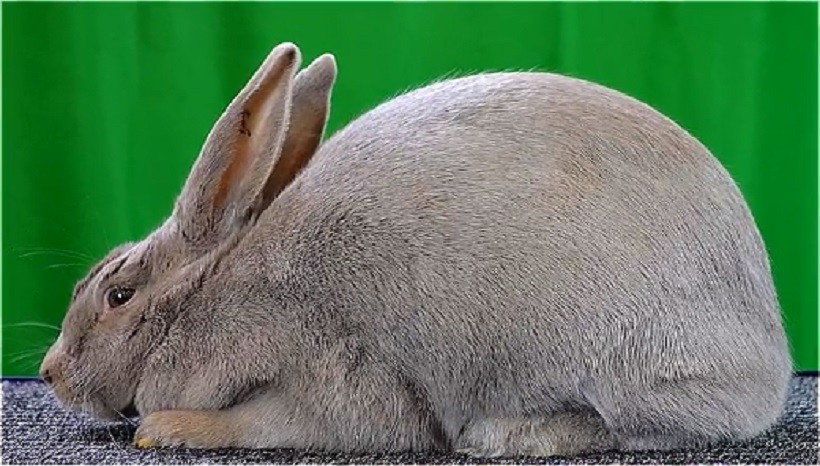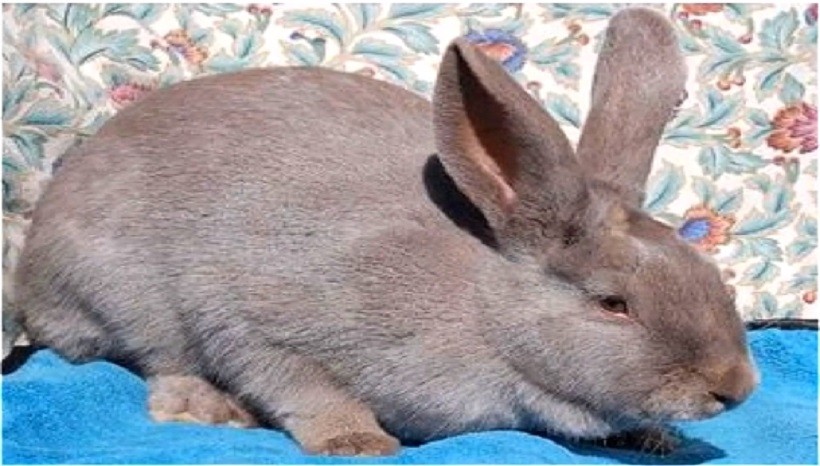Onslow of Cambridge first displayed lilac rabbits in the London Rabbit Exhibition in 1913, and Mabel Illingworth also created lilac rabbits that year by crossing Blue Imperial with Havana. Later in 1917, Blue Beverens was crossed with Havanas, and slightly bigger lilac rabbits, known as ‘Gouda’ or ‘Gouwenaar’ were developed by C.H. Spruty. R.C. Continental Giant Rabbit is the largest breed. Continental Giant Rabbit is the largest breed and also use for meat.
Punnett re-created these rabbits in 1922 by crossing Havanas and Blue Beverens, naming them “Cambridge Blue.” The three strains were united, and the pinkish-dove coloured rabbits were recognized as “lilac rabbits.” Learn more about Lionhead Rabbit Breeds, Care, Size, Diet, Personality.
There are several other Lilac strains, but the colours and sizes of the animals can vary greatly depending on breeder preferences. Here you can read more about Dutch rabbits Breeds.
They were first brought to America from England in 1922, but they never became as famous as other rabbit breeds. Other breeds of lilac rabbits have been tried and successfully bred by Americans, but the British have the honour of creating the most stunning colour hue of these rabbits. Our here you can read complete “Rabbit Breeds”.
Quick facts
Details
Specifications
Scientific name
Oryctolagus cuniculus
Species name
lilac rabbit
Class
Mammal
Order
Lagomorphs
Family
Leporids
Kingdom
Animalia
Life span
9-12years
Size/weight
6-8 pounds
Temperament
Friendly and joyful
Colours
lilac
Tank size
48” × 48”
Diet
Hay, leafy greens, vegetables
Lilac rabbit’s characteristics

Appearance
The body is slim, with an upper-body line that rises slightly. Pelage is fluffy and short, up to 1cm, and requires little care; a weekly brushing is all that is needed to keep the coat soft and smooth. It has 3.5 to 4 inches long ears that are moderately and uprightly positioned, and when mature, these rabbits can weigh up to 6 to 8 pounds. They are most likely known as a small to medium-sized rabbit breed, with short heads and large haunches.
Colour
Lilac rabbits only come in one regular colour, which is pretty obvious as ‘lilac or lavender.’ The American Rabbit Breeder Association (ARBA) refers to lilac as a pinkish shade of dove blue.
Light imparts a rare impact on its colour shade as it sometimes may seem greyer while on other times, it seems more bluish. The whole body is the same colour with no marks, and also the lilac rabbit’s eyes are blue-grey.
Lifespan
Lilac rabbits can live up to 9 to 12 years. But in order to live a longer lifespan, a healthy diet, clean environment, and care is required.
Lilac rabbit’s facts

Behavior
These rabbits are calm and docile, and they enjoy playing with others. They like being patted and sitting on humans lap. This are a perfect pet because of their sweet temperament and can quickly get used to smaller children in your home.
They still love playing with toys and discovering their surroundings; they can be kept both indoors and outdoors. These rabbits like cardboard boxes, toddler toys, ringing toys, bell toys, and other similar products to play with.
Breed
This rabbit is one of those species whose name is derived from its colour. Lilac is a distinct colour that is often termed pink-grey or dove blue. While its origin is unknown, the breeds developed by Onslow, Illingworth, and Punnett combined to produce the true lilac rabbit.
Because of its diverse bloodlines, this breed comes in a variety of sizes and colours. This rabbit is acknowledged by both American and British rabbit societies, but despite its affectionate appearance, it never gained widespread fame.
Diet
A hay-rich diet is required for the lilac rabbit’s healthy growth and immune system. Flystrike is extremely common in rabbits, particularly if they are kept outside. Flies will lay eggs in their fur in warmer temperatures, but to keep your rabbit safe, always check its fur.
Overgrown teeth are another common problem, and the cure is concealed in the hay, stressing the value of a well-balanced, hay-rich diet. Hay aids in the trimming of teeth to prevent overgrown teeth or it can be an extremely unpleasant condition for pet rabbits.
Fruits, green leafy vegetables, and pellets can also be included in the lilac rabbit’s diet, but in moderation; otherwise, digestive issues can occur.
Always check before feeding something to your rabbit as not all foods are rabbit-safe. Apart from alfalfa and carrots, lilac rabbits love wet foods, lettuce and timothy or orchard grass.
Health and care

The cage should be fairly large to let the rabbit hoops and walk around and also a rabbit companion is very necessary if you want your pet to be friendly and happy.
Along with healthy and balanced food, regular check-ups should be conducted on the pets to keep them and your family safe. Cleanliness is very important and if you are keeping them in cages, daily clean the bedding arrangement with white vinegar or some other cleaning product that is not hazardous to the pets.
Outdoor conditions are difficult to maintain but for the sake of your beloved rabbits, go to any length and keep them healthy and happy.
If keeping them outdoor, make proper arrangements to protect them from harsh weather conditions as well as from predators. While indoor cages must have a wire fence and plastic floor for bedding settlement.
Daily cleaning is of utmost importance or it may seriously affect the rabbit’s health. Furthermore, if you want to keep them, purchase a pair; otherwise, a single rabbit will become ill due to loneliness.
Lilac rabbits for sale

Lilac or dove-blue rabbits seem to be very rare, so if you wish to purchase one, contact a breeder or the National Lilac Rabbit Club of America. The price range varies widely depending on the size, vaccination, or condition of the animal, as well as the food and cage you select for it.
Conclusion
They are an utterly cute and beautiful companion to adopt, and they soon become used to the humans around them. Lilac rabbits are gregarious creatures that enjoy playing and can sit on your lap for hours.
Their lightweight, gorgeous features, silky smooth coat, and amiable temperament make them extremely compatible with kids, single individuals, elderly people, and even married couples; all you need to do is give them proper care and affection, and they will be very friendly to you and even your other pets like dogs or cats, in no time.
FAQS
1. How long can a lilac rabbit live?
A lilac rabbit can live for more than 9 years but no longer than 12 years. Many considerations, including cleanliness, a balanced diet, a playing partner, among others, all contribute significantly to extending their lifespan. Since they are sociable species, it is important to protect them from other predators and to provide them with enough love and attention to keep them healthy and happy.
If you want to learn more about pets visit us at petshoods
{ "@context": "https://schema.org", "@type": "Article", "mainEntityOfPage": { "@type": "WebPage", "@id": "https://petshoods.com/lilac-rabbit-facts-sale/" }, "headline": "Lilac Rabbit | Characteristics, Facts, Sale", "description": "Lilac Rabbit Is A Breed With A Rare Colour, Created By Crossing Blue Beverens And Havanas. Lilac Rabbits Are Beautiful And Absolutely Adorable Pets To Take Into Your Home.", "image": "https://petshoods.com/wp-content/uploads/2021/05/Lilac-Rabbit.jpg", "author": { "@type": "Person", "name": "Jeremy" }, "publisher": { "@type": "Organization", "name": "Petshoods", "logo": { "@type": "ImageObject", "url": "https://petshoods.com/wp-content/uploads/2019/02/13925402_1502331219793083_1620090286454245017_n.jpg" } }, "datePublished": "2021-05-12", "dateModified": "2021-07-15" } { "@context": "https://schema.org/", "@type": "ItemList", "itemListElement": [ { "@type": "ListItem", "position": 1, "name": "Quick facts", "url": "https://petshoods.com/lilac-rabbit-facts-sale/#Quick_facts" }, { "@type": "ListItem", "position": 2, "name": "Lilac rabbits characteristics", "url": "https://petshoods.com/lilac-rabbit-facts-sale/#Lilac_rabbits_characteristics" }, { "@type": "ListItem", "position": 3, "name": "Lilac rabbits facts", "url": "https://petshoods.com/lilac-rabbit-facts-sale/#Lilac_rabbits_facts" }, { "@type": "ListItem", "position": 4, "name": "Health and care", "url": "https://petshoods.com/lilac-rabbit-facts-sale/#Health_and_care" } ] } { "@context": "https://schema.org", "@type": "FAQPage", "mainEntity": { "@type": "Question", "name": "How long can a lilac rabbit live?", "acceptedAnswer": { "@type": "Answer", "text": "A lilac rabbit can live for more than 9 years but no longer than 12 years. Many considerations, including cleanliness, a balanced diet, a playing partner, among others, all contribute significantly to extending their lifespan. Since they are sociable species, it is important to protect them from other predators and to provide them with enough love and attention to keep them healthy and happy." } } }